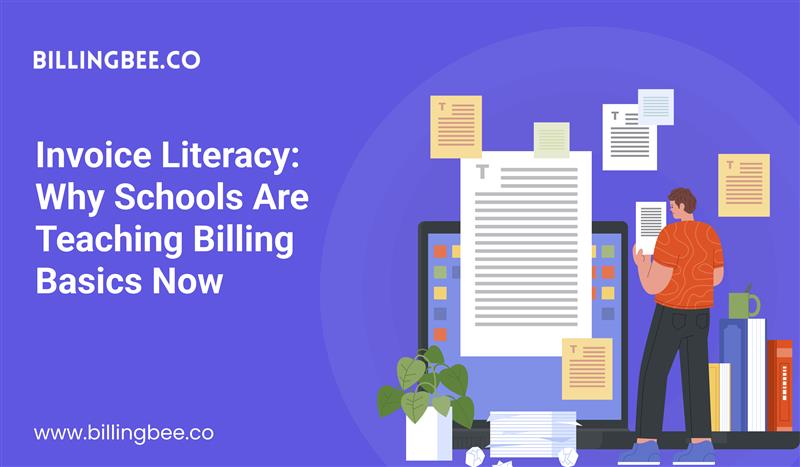Invoice Literacy: Why Schools Are Teaching Billing Basics Now




Until recently, most students left school knowing how to solve trigonometric equations but utterly clueless about sending an invoice or tracking a payment. Today, that’s starting to change.
Across parts of Asia—particularly in India, Singapore, and even the UAE—a quiet but important shift is happening in education. Financial literacy, once an afterthought, is stepping into the spotlight. And within that movement, a surprisingly specific topic is gaining traction: invoice literacy.
In this blog, we explore why schools are teaching students how to generate invoices, manage payment cycles, and understand the business of getting paid—and why this change is long overdue.
Why Invoice Literacy? Why Now?
Let’s start with a fundamental truth:
The future of work is independent.
With the global rise of gig workers, creators, freelancers, and remote consultants, the path to earning a living no longer passes solely through traditional 9-to-5 jobs. People are building careers on YouTube, running digital storefronts, offering tutoring services online, or selling their art on global marketplaces.
But while students are encouraged to dream big, they’re rarely taught how to handle the basic tools of the real world. That includes how to:
- Charge for their work
- Follow up on delayed payments
- Create legally compliant invoices
- Keep track of earnings for tax purposes
Imagine a teenager in Singapore running a digital art commission business online. She may be a talented illustrator, but if she doesn’t know how to create a clean, professional invoice, she’s at a disadvantage. And if she doesn’t know how to ensure she gets paid on time, her business stalls before it begins.
That’s where invoice literacy enters the picture.
From the Classroom to the Client: Real-World Education
Forward-thinking schools are starting to recognize that invoice skills aren’t just "extra"—they’re essential.
Here’s what the modern invoice curriculum looks like in some Asian institutions:
1. Simulated Freelance Projects
Students are asked to role-play as service providers—photographers, developers, content writers—and simulate client interactions, project scoping, and invoice creation.
2. Tech-Integrated Billing Exercises
Using simplified tools or platforms, students learn how to input invoice details, set payment terms, and generate PDF invoices with branded templates.
3. Peer-to-Peer Payment Cycles
In mock economies or class "business weeks," students invoice one another for goods or services to learn how payment cycles and client follow-ups work.
4. Discussion of Legal and Tax Basics
Basic invoicing regulations, GST/VAT rules, and the importance of accurate documentation are introduced to build early awareness of financial compliance.
The Larger Shift: Financial Independence as Core Curriculum
What’s happening isn’t just about invoices. It’s about empowering students with real-world tools so they don’t enter adulthood unprepared.
In India, the CBSE curriculum has already begun integrating financial literacy modules under commerce and vocational subjects. Singapore’s Ministry of Education has introduced budgeting and entrepreneurship workshops at the secondary level. Schools in the Philippines and Malaysia are piloting similar programs.
These systems recognize that independence isn’t just about knowledge—it’s about execution. Knowing what a bill is doesn’t help much if you can’t generate one. Knowing what income means doesn’t help if you don’t know how to follow up when it’s delayed.
Where Software Comes In
While the intention here isn’t to turn every student into an accountant, modern digital billing tools can play a key role. Platforms like BillingBee (and others) offer intuitive, clutter-free interfaces that could one day be adapted for educational modules.
Imagine a “student version” of a billing app, integrated into school systems, where learners can create mock invoices, track “pretend” payments, and see how real financial workflows function—without needing advanced accounting skills.
When education meets technology, the result isn’t just understanding. It’s capability.
A New Definition of Career-Ready
Being career-ready in 2025 isn’t just about a resume. It’s about being able to handle the messy, admin-heavy, day-to-day realities of work—whether you’re a solo artist or a startup founder.
That’s why invoice literacy matters. It’s not about teaching students one more thing—they already have enough on their plates. It’s about replacing outdated lessons with relevant ones.
Trapezoids can wait.
Teaching kids how to charge fairly for their work shouldn’t.
Final Thought: The First Invoice Is a Milestone
Your first invoice is more than just a document—it’s a declaration. It says: My work has value.
By introducing students to this idea early, we’re not just teaching them how to bill. We’re teaching them to believe that their skills, time, and effort matter—and that they should be compensated accordingly.
In a world that’s rapidly decentralizing work, that belief may be the most valuable lesson of all.